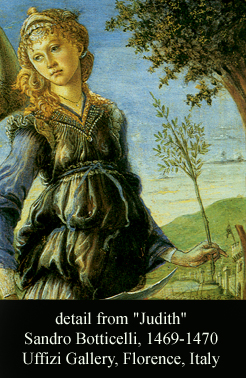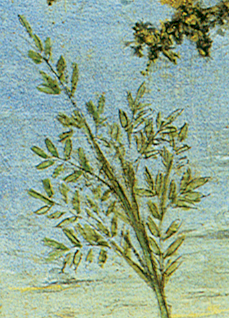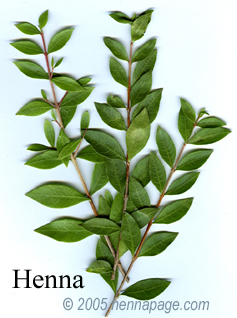 Hanukkah celebrations include the story of Judith and Holofernes, written in the book of Judith, one of the books of the Apocrypha. Judith was a pious beautiful Jewish woman who saved her people through bravery and guile by seducing Holofernes, an Assyrian general who was sieging her town. She beheaded him when he was drunk, infatuated, and near naked, and the siege was ended. For more information about the story of Judith, see: http://www.jwa.org/discover/throughtheyear/december/judith/ http://www.chabad.org/holidays/chanukah/article.asp?AID=103019 http://en.wikipedia.org/wiki/Judith View Botticelli's
painting at http://www.wga.hu/art/b/botticel/1early/12judith.jpg
Could
Judith have been holding a henna branch?
The branch from Botticelli's painting of Judith compared to henna branches.   The branch in Judith's hand has
been interpreted as an olive branch, a sign of peace, and as a myrtle,
a symbol of Venus. Botticelli frequently used plants as narrative
symbolism in his paintings, particularly his allegorical
paintings.
Could Judith's branch have been an olive branch? The branch in Judith's hand more closely resembles a henna branch than an olive branch. The pairing of leaves along the stem is correct, but olive leaves are more elongated than those depicted. View pictures of
olive leaves at: http://en.wikipedia.org/wiki/Image:Olive-tree-leaf-0.jpg
It would seem unusual that Botticelli would paint an
olive leaves inaccurately,
as he must have been familiar with olive trees growing in Italy. In
Pallas and the Centaur, painted by Botticelli in 1482, there is a
depiction of olive branches surrounding Pallas Athena. These
leaves
are darker and more elongated than the branch in the Judith painting,
and the branches are pliable, not rigid. View pictures of olive branches at: http://www.lifeinitaly.com/food/olives.asp View additional pictures of olive trees and branches at: http://www.eastofedenplants.co.uk/olive_guide.htm View Pallas and the Centaur by
Botticelli: http://www.wga.hu/art/b/botticel/5allegor/20pallas.jpg
Could Judith's branch have been myrtle?
Crape myrtles are Lythraceae (loosestrife family) as are henna. Myrtle closely resembles henna, and Botticelli frequently painted myrtle into his paintings, especially in conjunction with Venus, as in his painting, Primavera, 1482, Galleria degli Uffizi, Florence. View pictures of Botticelli's other allegorical paintings at: http://www.wga.hu/frames-e.html?/html/b/botticel/5allegor/40venusm.html View Venus with Myrtle at: http://www.wga.hu/art/b/botticel/5allegor/12primav.jpg
The leaves on Venus's myrtles are much darker and larger than the
leaves on
Judith's branch. The leaves
on Judith's branch are not longer than the length from the tip of her
thumb to the middle knuckle, about 3 cm in real life. The myrtle
leaves that accompany Venus in Primavera are as long as the length of
the tip of her thumb to the base of the thumb, about 6 cm, even without
allowing for perspective. Henna leaves are about 3 cm long, and
never grow 6 cm long.For more information on Myrtle see: http://en.wikipedia.org/wiki/Myrtle Could Judith's branch have been henna? Could Botticelli, in 15th century Florence, have been aware of henna, or that it symbolized victory? Henna would not have grown in Florence, but it could easily have grown in southernmost Italy and Sicily. Since Botticelli painted orange trees with blossoms in his paintings, he was aware of plants that did not grow in the immediate vicinity of Florence. See a map of Italy: http://www.cia.gov/cia/publications/factbook/geos/it.html
It is plausible that Botticelli could have seen a living henna plant, or at least a few branches that had been pressed and dried. Henna was widely used in Turkey during the Renaissance century for hair and skin adornment, and Italian travelers to Turkey described such. Florentine and Venetian merchants imported goods from Istanbul, and this may have included henna. See information on henna in Turkey during the Renaissance: http://www.hennapage.com/henna/encyclopedia/turkish/hamam.html http://www.hennapage.com/henna/encyclopedia/turkish/ottowomen.html Therefore, it is plausible that
Botticelli could have known about henna. Could he have known that
henna was used in connection with victory in battle? It would be
difficult to prove that Botticelli was familiar with the Middle Eastern
tradition of women celebrating victory with henna: but neither
would it be impossible for him to be aware of such. Both Arabic
and Jewish texts were kept in homes and libraries through Southern
Europe prior to the Inquisition.
See information about women's use
of henna in victory celebrations: http://www.hennapage.com/henna/encyclopedia/war/hadramaut.html
http://www.hennapage.com/henna/encyclopedia/war/anathvsmot.html It is not possible to prove that Botticelli intended Judith's branch to be henna and to symbolize women's traditional use of henna in victory celebrations in the Middle East, but it does resemble a henna branch much more than it does an olive branch or a myrtle branch, and the symbolism is more consistent. Can't find
what you're looking for?
Try:
The Henna Page Main Index http://www.hennapage.com/henna/mainindex.html *"Henna,
the
Joyous Body Art"
the Encyclopedia of Henna Catherine Cartwright-Jones c 2000 registered with the US Library of Congress TXu 952-968 |